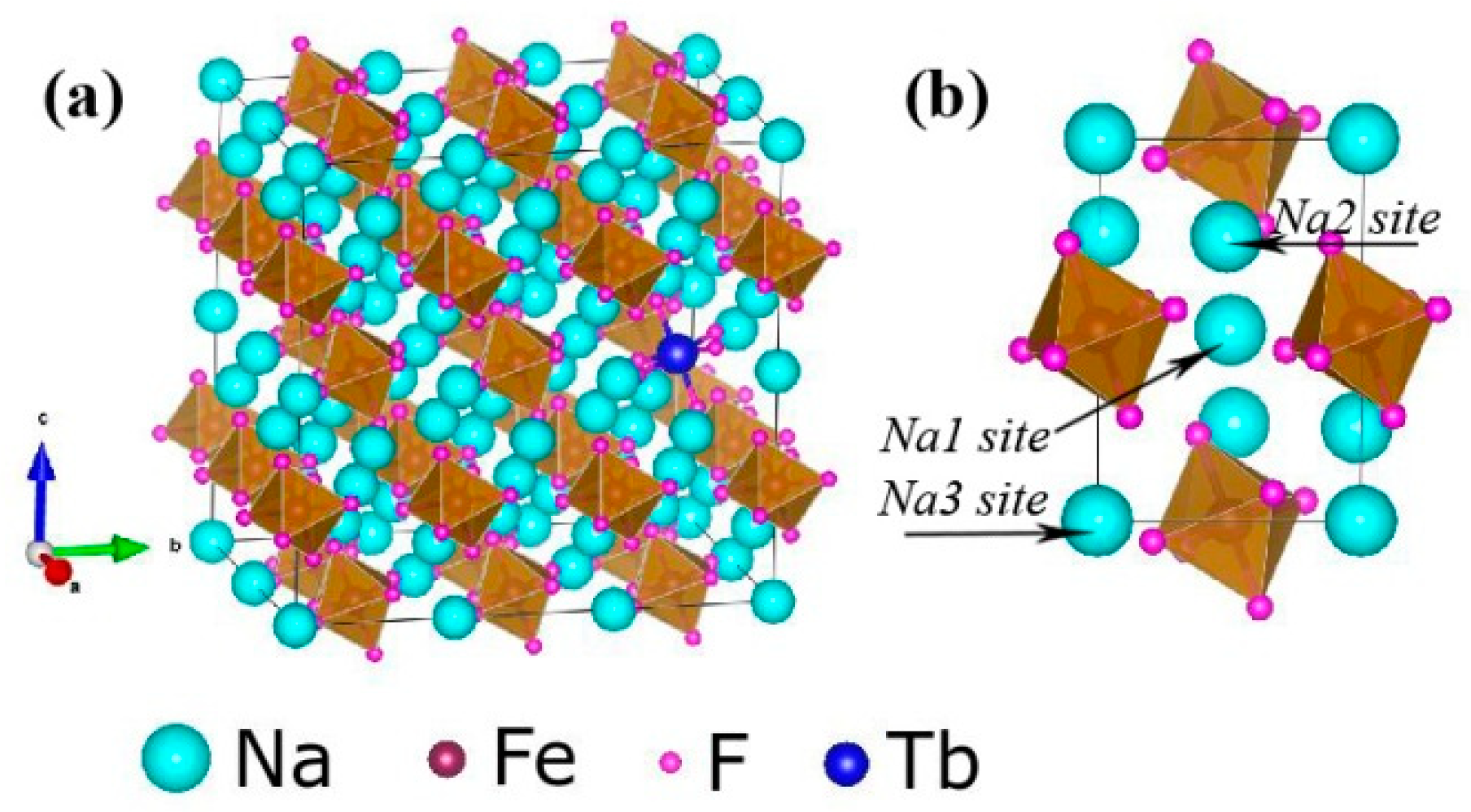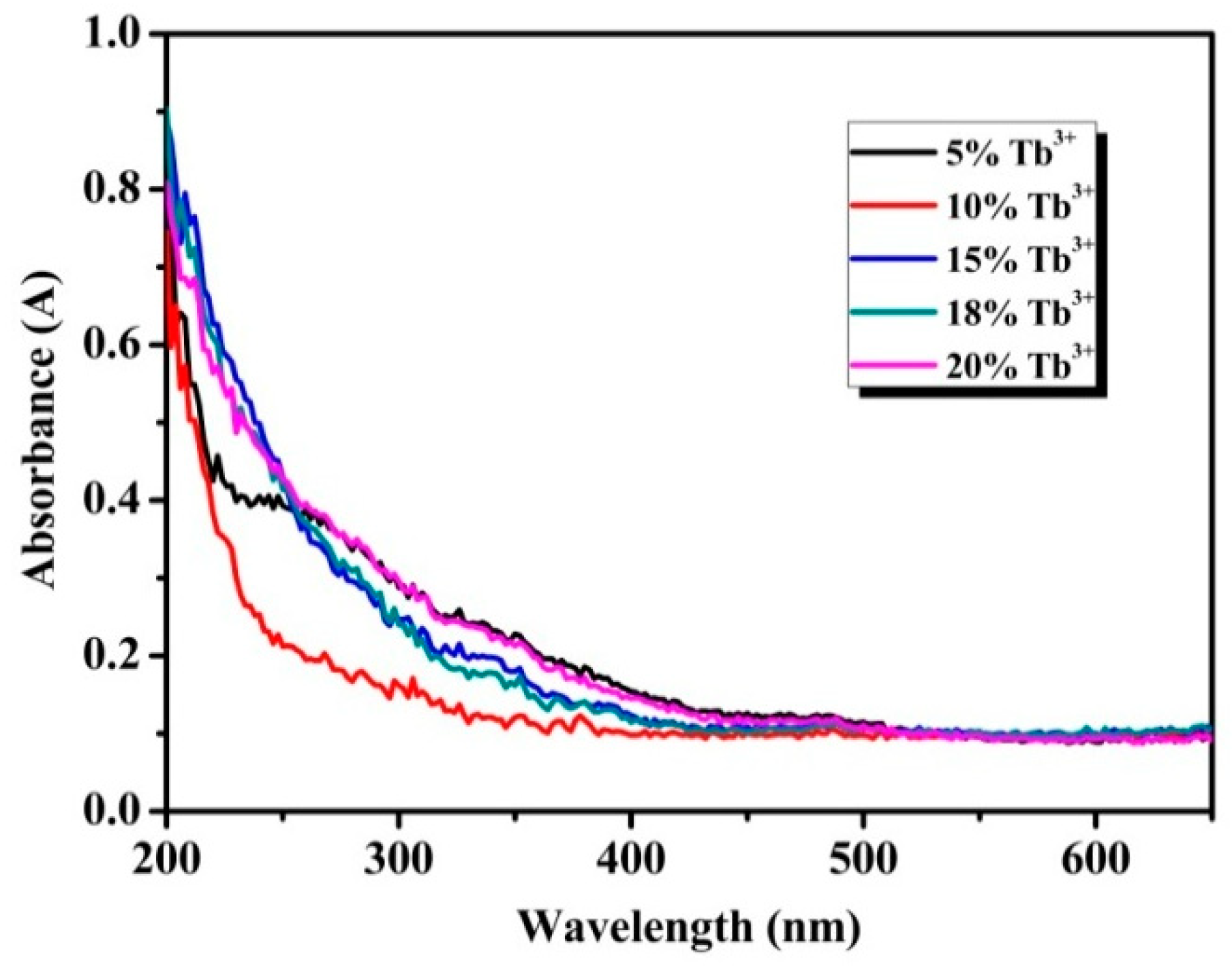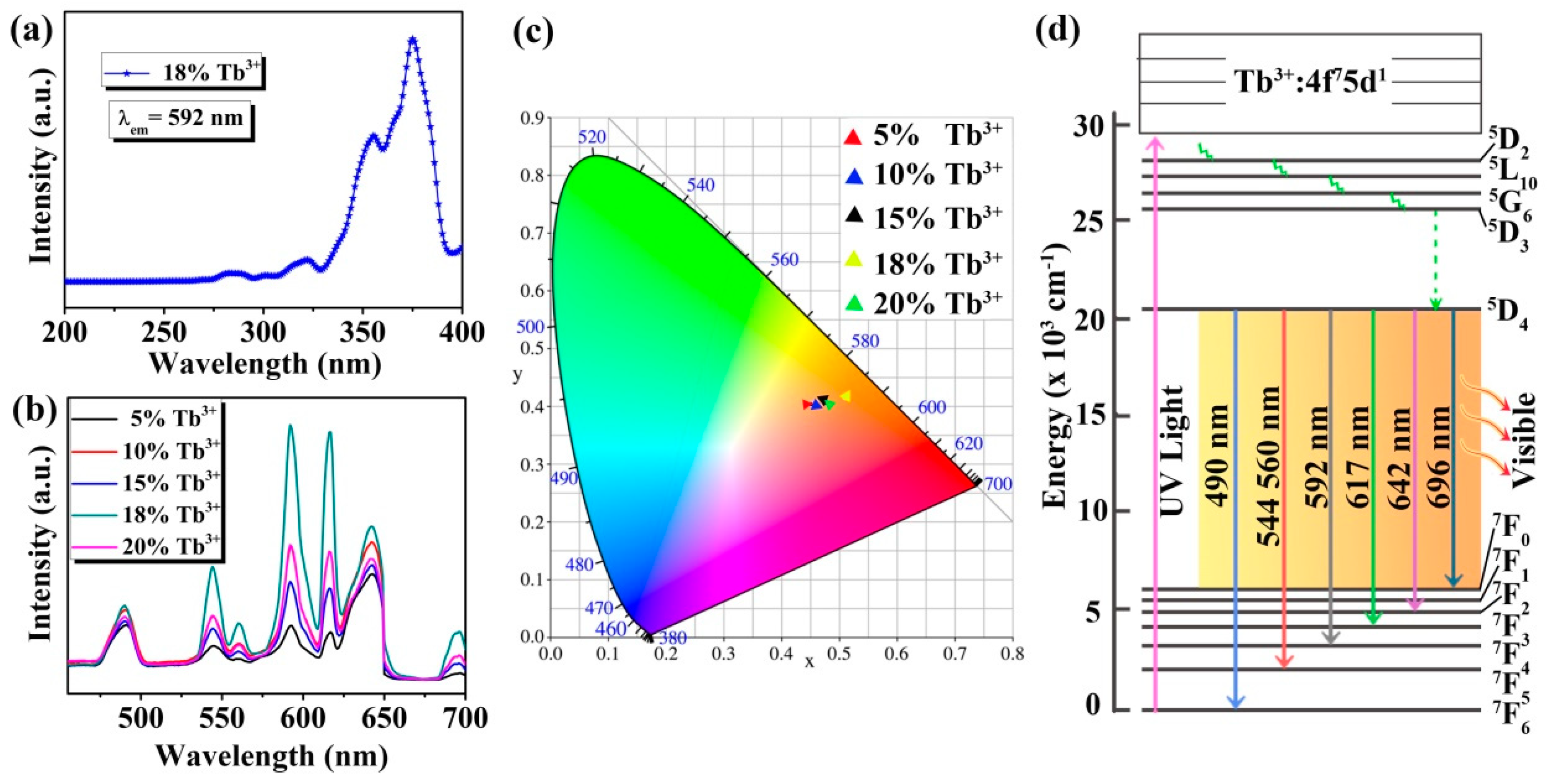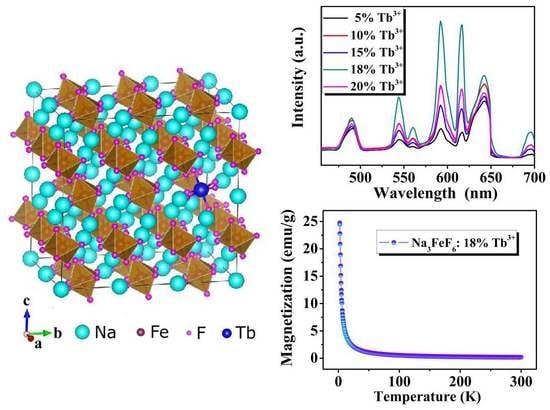Hydrothermal Synthesis and Optical Properties of Magneto-Optical Na3FeF6:Tb3+ Octahedral Particles
Abstract
1. Introduction
2. Materials and Methods
2.1. Synthesis of Na3FeF6:Tb3+ Particles
2.2. Characterization
3. Results and Discussion
4. Conclusions
Supplementary Materials
Author Contributions
Funding
Conflicts of Interest
References
- Gai, S.; Yang, P.; Li, C.; Wang, W.; Dai, Y.; Niu, N.; Lin, J. Synthesis of Magnetic, Up-Conversion Luminescent, and Mesoporous Core-Shell-Structured Nanocomposites as Drug Carriers. Adv. Funct. Mater. 2010, 20, 1166–1172. [Google Scholar] [CrossRef]
- Xiao, Q.; Zhang, Y.; Zhang, H.; Dong, G.; Han, J.; Qiu, J. Dynamically tuning the up-conversion luminescence of Er3+/Yb3+ co-doped sodium niobate nano-crystals through magnetic field. Sci. Rep. 2016, 6, 31327. [Google Scholar] [CrossRef] [PubMed]
- Huang, C.C.; Su, C.H.; Liao, M.Y.; Yeh, C.S. Magneto-optical FeGa2O4 nanoparticles as dual-modality high contrast efficacy T-2 imaging and cathodoluminescent agents. PCCP 2009, 11, 6331–6334. [Google Scholar] [CrossRef] [PubMed]
- Huang, C.C.; Liu, T.Y.; Su, C.H.; Lo, Y.W.; Chen, J.H.; Yeh, C.S. Superparamagnetic hollow and paramagnetic porous Gd2O3 particles. Chem. Mater. 2008, 20, 3840–3848. [Google Scholar] [CrossRef]
- Jung, H.K.; Kim, C.H.; Hong, A.R.; Lee, S.H.; Kim, T.C.; Jang, H.S.; Kim, D.H. Luminescent and magnetic properties of cerium-doped yttrium aluminum garnet and yttrium iron garnet composites. Ceram. Int. 2019, 45, 9846–9851. [Google Scholar] [CrossRef]
- Chen, H.; Qi, B.; Moore, T.; Colvin, D.C.; Crawford, T.; Gore, J.C.; Alexis, F.; Mefford, O.T.; Anker, J.N. Synthesis of brightly PEGylated luminescent magnetic upconversion nanophosphors for deep tissue and dual MRI imaging. Small 2014, 10, 160–168. [Google Scholar] [CrossRef]
- Hu, Q.; Jia, Z.; Yin, Y.; Mu, W.; Zhang, J.; Tao, X. Crystal growth, thermal and optical properties of TSLAG magneto-optical crystals. J. Alloys Compd. 2019, 805, 496–501. [Google Scholar] [CrossRef]
- Li, J.; Tang, T.; Luo, L.; Li, N.; Zhang, P. Spin Hall effect of reflected light in dielectric magneto-optical thin film with a double-negative metamaterial substrate. Opt. Express 2017, 25, 19117–19128. [Google Scholar] [CrossRef]
- Yang, M.; Zhou, D.; Xu, J.; Tian, T.; Jia, R.; Wang, Z. Fabrication and magneto-optical property of yttria stabilized Tb2O3 transparent ceramics. J. Eur. Ceram. Soc. 2019, 39, 5005–5009. [Google Scholar] [CrossRef]
- Ye, S.; Zhang, Y.; He, H.; Qiu, J.; Dong, G. Simultaneous broadband near-infrared emission and magnetic properties of single phase Ni2+-doped β-Ga2O3 nanocrystals via mediated phase-controlled synthesis. J. Mater. Chem. C 2015, 3, 2886–2896. [Google Scholar] [CrossRef]
- Zhang, Y.; Xiao, Q.; He, H.; Zhang, J.; Dong, G.; Han, J.; Qiu, J. Simultaneous luminescence modulation and magnetic field detection via magneto-optical response of Eu3+-doped NaGdF4 nanocrystals. J. Mater. Chem. C 2015, 3, 10140–10145. [Google Scholar] [CrossRef]
- Gu, H.; Zheng, R.; Zhang, X.; Xu, B. Facile one-pot synthesis of bifunctional heterodimers of nanoparticles: A conjugate of quantum dot and magnetic nanoparticles. J. Am. Chem. Soc. 2004, 126, 5664–5665. [Google Scholar] [CrossRef] [PubMed]
- Zhang, F.; Braun, G.B.; Pallaoro, A.; Zhang, Y.; Shi, Y.; Cui, D.; Moskovits, M.; Zhao, D.; Stucky, G.D. Mesoporous multifunctional upconversion luminescent and magnetic “nanorattle” materials for targeted chemotherapy. Nano Lett. 2011, 12, 61–67. [Google Scholar] [CrossRef] [PubMed]
- Jia, H.; Zhou, Y.; Li, X.; Li, Y.; Zhang, W.; Fu, H.; Zhao, J.; Pan, L.; Liu, X.; Qiu, J. Synthesis and phase transformation of NaGdF4: Yb–Er thin films using electro-deposition method at moderate temperatures. CrystEngComm 2018, 20, 6919–6924. [Google Scholar] [CrossRef]
- Jia, H.; Liu, Z.; Liao, L.; Gu, Y.; Ding, C.; Zhao, J.; Zhang, W.; Hu, X.; Feng, X.; Chen, Z. Upconversion Luminescence from Ln3+ (Ho3+, Pr3+) Ion-Doped BaCl2 Particles via NIR Light of Sun Excitation. J. Phys. Chem. C 2018, 122, 9606–9610. [Google Scholar] [CrossRef]
- Tan, C.; Ma, B.; Zhang, J.; Zuo, Y.; Zhu, W.; Liu, Y.; Li, W.; Zhang, Y. Pure red upconversion photoluminescence and paramagnetic properties of Gd2O3: Yb3⁺, Er3⁺ nanotubes prepared via a facile hydrothermal process. Mater. Lett. 2012, 73, 147–149. [Google Scholar] [CrossRef]
- Zhang, L.; Yin, M.; You, H.; Yang, M.; Song, Y.; Huang, Y. Mutifuntional GdPO4: Eu3+ hollow spheres: Synthesis and magnetic and luminescent properties. Inorg. Chem. 2011, 50, 10608–10613. [Google Scholar] [CrossRef]
- Ma, Z.W.; Zhang, J.P.; Wang, X.; Yu, Y.; Han, J.B.; Du, G.H.; Li, L. Magnetic field induced great photoluminescence enhancement in an Er3+: YVO4 single crystal used for high magnetic field calibration. Opt. Lett. 2013, 38, 3754–3757. [Google Scholar] [CrossRef]
- Zhu, X.; Tu, H.; Hu, Z.; Zhuang, N. Enhancement of magneto-optical performance of Tb0.94Pr0.06VO4 single crystals by Pr doping. Mater. Lett. 2019, 242, 195–198. [Google Scholar] [CrossRef]
- Chen, P.; Zhong, Z.; Jia, H.; Zhou, J.; Han, J.; Liu, X.; Qiu, J. Magnetic field enhanced upconversion luminescence and magnetic-optical hysteresis behaviors in NaYF4: Yb, Ho nanoparticles. RSC Adv. 2016, 6, 7391–7395. [Google Scholar] [CrossRef][Green Version]
- Zhang, L.; Wang, Y.S.; Yang, Y.; Zhang, F.; Dong, W.F.; Zhou, S.Y.; Pei, W.H.; Chen, H.D.; Sun, H.B. Magnetic/upconversion luminescent mesoparticles of Fe3O4@ LaF3: Yb3+, Er3+ for dual-modal bioimaging. Chem. Commun. 2012, 48, 11238–11240. [Google Scholar] [CrossRef] [PubMed]
- Peng, H.; Cui, B.; Li, G.; Wang, Y.; Li, N.; Chang, Z.; Wang, Y. A multifunctional β-CD-modified Fe3O4@ ZnO: Er3+, Yb3+ nanocarrier for antitumor drug delivery and microwave-triggered drug release. Mater. Sci. Eng. C 2015, 46, 253–263. [Google Scholar] [CrossRef] [PubMed]
- Zhang, Y.; Pan, S.; Teng, X.; Luo, Y.; Li, G. Bifunctional magnetic- luminescent nanocomposites: Y2O3/Tb nanorods on the surface of iron oxide/silica core-shell nanostructures. J. Phys. Chem. C 2008, 112, 9623–9626. [Google Scholar] [CrossRef]
- Brunton, G. The crystal structure of Na3CrF6. Mater. Res. Bull. 1969, 4, 621–626. [Google Scholar] [CrossRef]
- Shakoor, R.A.; Lim, S.Y.; Kim, H.; Nam, K.W.; Kang, J.K.; Kang, K.; Choi, J.W. Mechanochemical synthesis and electrochemical behavior of Na3FeF6 in sodium and lithium batteries. Solid State Ion. 2012, 218, 35–40. [Google Scholar] [CrossRef]
- Chen, J.Y.; Lin, C.W.; Lin, P.H.; Li, C.W.; Liang, Y.M.; Liu, J.C.; Chen, S.S. Fluoride recovery from spent fluoride etching solution through crystallization of Na3AlF6 (synthetic cryolite). Sep. Purif. Technol. 2014, 137, 53–58. [Google Scholar] [CrossRef]
- Jia, H.; Zhou, Y.; Wang, X.; Zhang, W.; Feng, X.; Li, Z.; Fu, H.; Zhao, J.; Liu, Z.; Liu, X. Luminescent properties of Eu-doped magnetic Na3FeF6. RSC Adv. 2018, 8, 38410–38415. [Google Scholar] [CrossRef]
- Pang, Y.L.; Abdullah, A.Z. Effect of low Fe3+ doping on characteristics, sonocatalytic activity and reusability of TiO2 nanotubes catalysts for removal of Rhodamine B from water. J. Hazard. Mater. 2012, 235, 326–335. [Google Scholar] [CrossRef]
- Li, X.; Dong, M.; Hu, F.; Qin, Y.; Zhao, L.; Wei, X.; Chen, Y.; Duan, C.; Yin, M. Efficient sensitization of Tb3+ emission by Dy3+ in CaMoO4 phosphors: Energy transfer, tunable emission and optical thermometry. Ceram. Int. 2016, 42, 6094–6099. [Google Scholar] [CrossRef]
- Bi, F.; Dong, X.; Wang, J.; Liu, G. Electrospinning preparation and photoluminescence properties of Y3Al5O12: Tb3+ nanostructures. Luminescence 2015, 30, 751–759. [Google Scholar] [CrossRef]
- Singh, V.; Singh, N.; Pathak, M.S.; Singh, P.K.; Natarajan, V. Tb3+ doped Ca2La8 (SiO4) 6O2 oxyapatite phosphors. Optik 2018, 171, 356–362. [Google Scholar] [CrossRef]
- Kumar, J.S.; Pavani, K.; Sasikala, T.; Jayasimhadri, M.; Jang, K.; Moorthy, L.R. Concentration dependent luminescence characteristics of 5D4 and 5D3 excited states of Tb3+ ions in CFB glasses. Proc. SPIE 2011, 79401H. [Google Scholar] [CrossRef]
- Cho, I.; Kang, J.G.; Sohn, Y. Photoluminescence imaging of SiO2@ Y2O3: Eu (III) and SiO2@ Y2O3: Tb (III) core-shell nanostructures. Bull. Korean Chem. Soc. 2014, 35, 575–580. [Google Scholar] [CrossRef]
- Wang, D.Y.; Chen, Y.C.; Huang, C.H.; Cheng, B.M.; Chen, T.M. Photoluminescence investigations on a novel green-emitting phosphor Ba3Sc (BO3)3: Tb3+ using synchrotron vacuum ultraviolet radiation. J. Mater. Chem. 2012, 22, 9957–9962. [Google Scholar] [CrossRef]
- Van Do, P.; Quang, V.X.; Thanh, L.D.; Tuyen, V.P.; Ca, N.X.; Hoa, V.X.; Van Tuyen, H. Energy transfer and white light emission of KGdF4 polycrystalline co-doped with Tb3+/Sm3+ ions. Opt. Mater. 2019, 92, 174–180. [Google Scholar] [CrossRef]
- Shi, J.; Wang, Y.; Huang, L.; Lu, P.; Sun, Q.; Wang, Y.; Tang, J.; Belfiore, L.A.; Kipper, M.J. Polyvinylpyrrolidone nanofibers encapsulating an anhydrous preparation of fluorescent SiO2-Tb3+ nanoparticles. Nanomaterials 2019, 9, 510. [Google Scholar] [CrossRef] [PubMed]
- Blasse, G.; Bril, A. Investigations of Tb3+-activated phosphors. Philips Res. Rep. 1967, 22, 481–504. [Google Scholar]
- Scholl, M.S.; Trimmier, J.R. Luminescence of YAG: Tm, Tb. J. Electrochem. Soc. 1986, 133, 643–648. [Google Scholar] [CrossRef]






© 2020 by the authors. Licensee MDPI, Basel, Switzerland. This article is an open access article distributed under the terms and conditions of the Creative Commons Attribution (CC BY) license (http://creativecommons.org/licenses/by/4.0/).
Share and Cite
Zhao, Z.; Li, X. Hydrothermal Synthesis and Optical Properties of Magneto-Optical Na3FeF6:Tb3+ Octahedral Particles. Materials 2020, 13, 320. https://doi.org/10.3390/ma13020320
Zhao Z, Li X. Hydrothermal Synthesis and Optical Properties of Magneto-Optical Na3FeF6:Tb3+ Octahedral Particles. Materials. 2020; 13(2):320. https://doi.org/10.3390/ma13020320
Chicago/Turabian StyleZhao, Zhiguo, and Xue Li. 2020. "Hydrothermal Synthesis and Optical Properties of Magneto-Optical Na3FeF6:Tb3+ Octahedral Particles" Materials 13, no. 2: 320. https://doi.org/10.3390/ma13020320
APA StyleZhao, Z., & Li, X. (2020). Hydrothermal Synthesis and Optical Properties of Magneto-Optical Na3FeF6:Tb3+ Octahedral Particles. Materials, 13(2), 320. https://doi.org/10.3390/ma13020320





